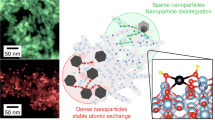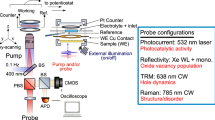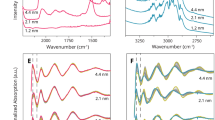Abstract
Heterogeneous catalysis has played a major role in the development of the chemical industry1. Metal oxide catalysts, for example, are used in selective oxidation and ammoxidation of hydrocarbons to produce key industrial chemicals. The activity and selectivity of such catalysts are greatly influenced by their microstructural and electronic structure changes under operating conditions. Here we report the first investigation of the electronic properties of small selected areas of catalyst particles, each only a few micrometers in extent, using a scanning electron microscope technique originally developed for characterizing semiconductor materials. The wavelength of the light emitted by selective electron probe stimulation (cathodoluminescence) can be directly related to the local bandgap energy of the material and the intensity of the signal to the point defect level. Some interpretation is required, but there are minimal specimen preparation requirements and the process is essentially non-destructive so that development sequences can be followed. In favourable cases the important aggregations of point defects can be mapped with respect to other microstructural features. An electronic contribution to promoter mechanisms is suggested.
This is a preview of subscription content, access via your institution
Access options
Subscribe to this journal
Receive 51 print issues and online access
$199.00 per year
only $3.90 per issue
Buy this article
- Purchase on Springer Link
- Instant access to full article PDF
Prices may be subject to local taxes which are calculated during checkout
Similar content being viewed by others
References
Hucknall, D. J. in Selective Oxidation of Hydrocarbons (Academic, New York, 1974).
Stone, F. S. J. Solid State Chem. 12, 271–281 (1975).
Gai, P. L., Boyes, E. D. & Bart, J. C. J. Phil. Mag. A45, 531–547 (1982).
Gai, P. L. J. Solid State Chem. 49, 25–42 (1983).
Gai, P. L. Phil. Mag. A43, 841–857 (1981).
Holt, D. B. Inst. Phys.(Lond.) Conf. Ser. 60, 165–178 (1981).
Booker, G. R. Inst. Phys. (Land). Conf. Ser. 60, 203–214 (1981).
Boyes, E. D. & Gai, P. L. Proceedings of AEM workshop, Microbeam Analytical Society, Vail (ed. Geiss, R.) 71–75 (San Francisco Press, San Francisco, 1981).
Rao, C. N. R. & Subbarao, G. V. Phys. Stat. Sol. A1, 597–614 (1970).
Blanchin, M., Bursill, L. A., Hutchison, J. & Gai, P. L. J. Physique 42, 95–110 (1981).
Mackrodt, W. C. in Computer Simulation in the Physics and Chemistry of Solids, 71–82 (Daresbury Laboratory, 1980).
Warwick, C. A. & Booker, G. R. Inst. Phys. Conf. Ser. 67, 321–326 (1983).
Author information
Authors and Affiliations
Rights and permissions
About this article
Cite this article
Boyes, E., Gai, P. & Warwick, C. Cathodoluminescence of catalyst crystallites. Nature 313, 666–668 (1985). https://doi.org/10.1038/313666a0
Received:
Accepted:
Issue Date:
DOI: https://doi.org/10.1038/313666a0
This article is cited by
-
Bulk diffusion of metal particles on ceramic substrates
Nature (1990)
Comments
By submitting a comment you agree to abide by our Terms and Community Guidelines. If you find something abusive or that does not comply with our terms or guidelines please flag it as inappropriate.



